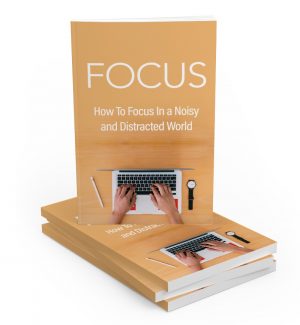 License Type: Master Resell Rights
License Type: Master Resell Rights  File Type: ZIP
File Type: ZIP
 SKU: 63800
SKU: 63800  Shipping: Online Download
Shipping: Online Download
Sample Content Preview
Introduction
Maintaining your focus in a noisy and distracted world can be tough. There is so much pulling our attention in every direction that it seems almost impossible to focus on the tasks that are truly important. From social media to text messages and calls and even people stopping by to talk, there is always something that can take our attention away from getting work done.
The result is that we feel like we are behind. When we spend most of our day checking notifications on Facebook or responding to unimportant emails, we find that there is very little time left to get projects and other work done. This can leave us feeling overwhelmed and may drive us to overwork ourselves, while feeling like we get nothing done.
This guidebook is here to change all that. The goal is to learn how to focus our attention and manage our time so we no longer have to stay at work late to finish projects or waste time away from our loved ones. Inside, we will learn that we are the ones in control over our time, not the clock, and that we can actually get things done based on a schedule of our own choosing.
As we work through this guidebook, we will learn the importance of setting goals, minimizing distractions, and even taking breaks.
When it comes to focusing, we can work with some of the best time management techniques, including the Pomodoro Method and Eat the Frog to help us get more done. Slowly, by implementing some of these tips in one at a time, you can start to turn these ideas into habits and improve your focus when getting work done.
Stop letting this noisy and distracting world get the best of you. Stop being a slave to the clock and feeling like nothing gets done. Take a look through this guidebook and see the exact steps you can use to reclaim your time and your focus!
Chapter 1: The Psychology of Staying Focused
When we think about how many things are vying for our attention right now, the list seems endless. From a long to-do list to our phones, emails, family members and more, it seems almost impossible to keep up. While modern technology is amazing and has helped improve our world so much, there is the side effect of always getting our attention.
Think about your phone. It is common to see one notification after another popping up and distracting us from the things that we need to get done. All of a sudden we have wasted an hour and have a ton of work left to do. This continues to happen throughout the day and makes it impossible to get ahead.
You are not alone in this problem. The average office worker will find a distraction every three minutes. And Research from the Human-Computer Interaction Institute at Carnegie Mellon University says that it can take almost 25 minutes to get back on task after a distraction. Basically, it is easy to lose focus and hard to get it back. We may not have a problem with too much work, but rather a problem with too many distractions.
How the Brain Chooses What to Focus On During the day, your brain is always on and trying to gather and take in important information. This means that it has to sort through the noise and decide what it wants to focus on. This is called selective attention and there are two main forms that come with it:
Top-Down
This is also known as voluntary focus and it is one of the best types. With this focus, you pay attention to your goals. You look at the bigger picture and come up with a plan that helps you get there. You know that your phone and emails keep you from reaching these goals so you ignore them. You get stuff done on time, if not ahead of time.
Bottom-Up
This is more of a stimulus-driven focus. When a thought starts to creep up to you or a notification shows up on the phone and you get distracted, this is a sign that you work with bottom-up focus. You have to pay attention to what is going on around you, rather than the thing that deserves the most attention for you.
What’s the Problem Here?
The ultimate goal is to become a top-down thinker. This allows us to focus on what is important and avoid all the rest. Unfortunately, because of our natural instincts, we are often bottom-up focusers instead. Willpower and focus are finite resources, which means that the more you are distracted, the harder it is to get back on track. And since we are bottom-up focusers, every little thing is enough to distract us from our goals.
Since most of us can be easily distracted by little things like emails and notifications on our phones, we need to prepare for this. We need to be aware of it and limit the amount of distractions that we have during the day. Turning your phone off and staying away from social media, for example, can help keep the distractions down so your brain will not even realize they are there and you can focus on your work.
There is just too much that is adding to our focus problem and trying to draw our attention away from what is important. Those notifications, those emails, and those little things have a way of drawing us in, even if they are not that important at all. We think we just give them a few moments of our attention, but it does not take long for them to take over and then we get nothing done during the day.
Notifications are Just as Distracting as Phone Calls In the past, we would not know anyone was trying to contact us on our phones unless it rang. This was less frequent because most people had to have something important to talk about before they would go through the effort because it took some time for a phone conversation. Today, our phones often do not ring as much. But we may here a single beep or a vibration for a text or a Facebook message. And since these take the sender just a few moments, we may get a lot of them during the day.
A study from three researchers at Florida State University suggest that getting one of these notifications, no matter how small they may be, could distract us as much as responding to a text message or a phone call, even if we do not respond to it.
During this study, there were about 150 students who had to complete a test of sustained attentional performance. During this test, the subjects are given a series of single digits on a screen and a new digit will show up every second.
During this, the students are meant to tap on the keyboard each time the digit changes, unless the new digit is a 3. Each person did the test two times. The first time they did it without their devices there to interrupt them. The second time, they could have their phone and assistants to the test would text or place phone calls to these phones.
Through this, researchers found that the performance for that assessment suffered if the student receive audible notification on their phone of any kind. Each type of phone distraction, whether it was a phone call or a text, was destructive to how well they did. It didn’t seem to matter if the student didn’t answer the phone or ignored the text. If they got the notification, they still knew they had that notification and their performance suffered.
This is telling to our focus and it is an example of how bottom-up thinking works. Something as small as a text notification is enough to send our focus out the window and can make our performance suffer. Recognizing this and finding methods to limit the impact it has on our work can be critical if you want to improve how well you do at work.
- License: Master Resell Rights
- Category:Ebooks
- Tags:2021 Ebooks Master Resale Rights








